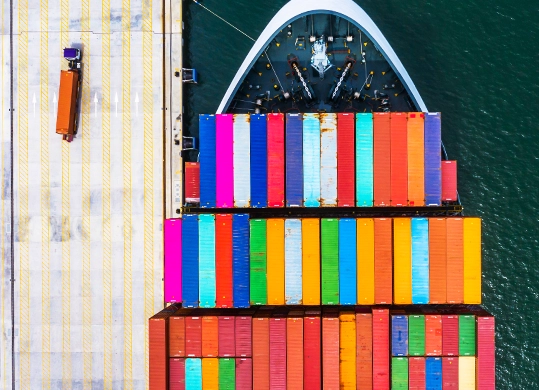Vessels continue to be pushed further off the proforma schedule causing blank sailings, and the continuous increase of import volume within the past two years has affected operations in almost all areas of the country, creating delays.
The current events in Ukraine are impacting vessel routing, schedules, ports, and rails, especially in Eastern Europe, aggravating delays and congestion.
COVID-19 sequels, labor shortage, and strong demand still impact the global supply chain. Lead times remain extended.
With all of the recently mentioned events, there is a high number of container vessels currently congested at different ports around the world, affecting logistics services overall.
Within the past few weeks, port congestion has become worse on the East Coast and Gulf Coast ports, especially in Savannah and Houston. Container availability in the USA is tight in the areas of the South Atlantic Coast and Gulf Coast.
Limited trucking and equipment availability are among the main challenges across the supply chain.
Labor shortages may worsen since cruise ship season has been reactivated, especially for the Pacific Northwest area.
Terminals Updates:
Due to increased volume and labor shortage, most terminals are experiencing congestion issues, including Los Angeles/Long Beach, Savannah, Charleston, Miami, Houston, and Seattle.
Each month, high cargo volumes continue to enter the U.S., with most North American ports facing berthing congestion.
Some carriers are omitting ports and altering schedules for services into US East Coast due to high congestion and delays.
U.S. East Coast:
New York/New Jersey: Vessel waiting time is up to 3 days due to high import volume and severe port congestion. Yard utilization is about 74%. Also, the rising movement of empty containers has contributed to slowing down operations; about 120 thousand empty boxes are clogging the yard, a figure that is double the usual number. Import dwell time at the APM terminal is 4.5 days. NJ/NY ports have 12 vessels on queue.
Savannah: Vessel waiting time is up to 17 days due to high import volume and port congestion. The terminal capacity is at 75% utilization.
Miami/Port Everglades: Vessel waiting time is up to 2 days due to high import volume. Overseas port congestion is affecting service from Port Everglades to East Coast South America, which has subsequently resulted in delays in operations and vessels being removed from schedules.
U.S. West Coast:
Los Angeles: Vessel waiting time is up to 13 days due to yard congestion, high import dwell, and labor shortages.
Long Beach: Vessel waiting time is up to 4 days due to high import dwell and labor shortage.
Limited appointments for empty return containers in the Los Angeles / Long Beach area.
Seattle: Vessel waiting time is up to 2 days due to high import volume and labor shortages. Vessels are arriving late due to delays at previous ports and routings.
Oakland: Vessel waiting time is up to 15 days due to high import volume and labor shortages. 90% of yard capacity is being used. Ships looking to berth in Oakland will now wait offshore, which will delay operations. The backlog is caused mainly due to a massive number of empty containers in terminals waiting to be returned to Asia. Terminals within the port are heavily congested. Containers stacked high are the result of lack of availability for timely pick-ups.
U.S. Gulf Coast:
Houston: Waiting time is up to 18 days due to high import volume, labor shortage, and port congestion.
Rail Terminal Updates:
Increased terminal dwell due to surge of import volume and labor shortage is the main challenges affecting rail services.
Limited rail equipment remains a challenge in Los Angeles.
BNSF & UP/LAX/LGB: There is severe congestion. Limited gate capacity, restrictions, rail car shortages, and limited reservations continue, causing increased delays on import rail units. There is limited allocation currently. In Los Angeles, containers wait an average of almost 16 days before being picked up.
Chicago Rail Ramp: The rail facilities in Chicago are experiencing severe congestion due to dwelling containers and chassis shortages. There are gate restrictions and lane suspensions, causing extended delays in pick-ups and deliveries. The rails continue to monitor in-gates with allocation or reservations.
CSX Bedford Park: Limiting reservations for in-gate to rail.
NY/NJ: Chassis shortage includes rail ramps due to the high increase in import volume.
Philadelphia: Severe chassis shortages in the Philadelphia area. Extended delays in pick-ups, deliveries, and drayage.
Charleston: Lack of chassis causing extended delays in pick-ups, deliveries, and drayage over to rail facilities. Chassis pool utilization is over 95%.
Savannah: Continued congestion and delays at the local ramps. Shortage of chassis and equipment continues to affect operations.
Jacksonville and Miami: The shortage of equipment in Florida has carriers struggling to keep the service due to a slower turnover of import containers coming into the area. Most loads have been delayed an average of one to two weeks. Equipment shortages are resulting in pick-up delays.
Seattle: Congestion due to increased dwell for Import rail cargo. Chassis pool utilization is over 80%.
Houston/Dallas: There is a severe chassis shortage and ongoing congestion in the area. Finding truckers has become a challenge as they are booked for 2-3 weeks in advance. Rail yard capacity is 49% used.
Chassis issues are challenging in all regions in the U.S. This is due to the division of the intermodal system and the lack of additional capacity at different levels of the supply chain.
Source: Shipco Transport Inc.

